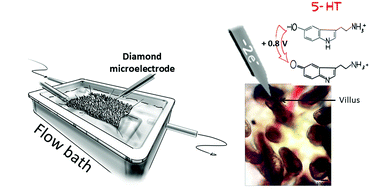In vitro electrochemical measurement of serotonin release in the human jejunum mucosa using a diamond microelectrode
Abstract
We report herein on the use of a boron-doped diamond microelectrode (DME) to record oxidation currents in vitro associated with the release of serotonin from enterochromaffin cells in the epithelium of the human intestinal mucosa. Continuous amperometric measurements were made as a function of distance (ln current vs. distance) from the tissue surface in human jejunum specimens. The results demonstrate the capabilities of the DME for the stable and reproducible detection of serotonin in the complex environment of the human tissue. Serotonin release was evoked by the shearing force of a continuously flowing Krebs buffer solution at 36 °C with the tissue pinned down in a flow bath. Reproducible currents with distance were recorded for serotonin oxidation. Increased oxidation currents were observed in the presence of the selective serotonin reuptake inhibitor, fluoxetine, indicating that a significant fraction of the amperometric current recorded is attributable to serotonin oxidation. The nominal reciprocal slope, |slope−1|, of the ln current vs. distance plots increased from 270 ± 25 μm−1 in Krebs buffer (N = 3) to 471 ± 65 μm−1 during fluoxetine addition (N = 3), reflective of a reduced rate of reuptake in the presence of the SERT antagonist. The paper reports on the characterization of the diamond microelectrodes and the in vitro electrochemical measurement data.



 Please wait while we load your content...
Please wait while we load your content...
